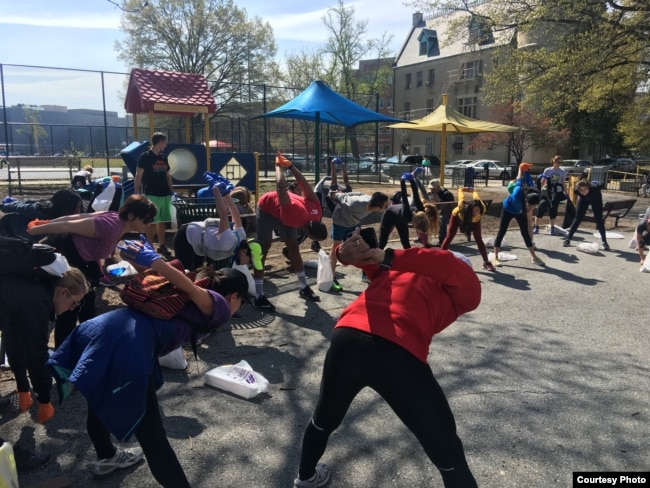Many athletes have been doing it for a long time without even knowing it is now a fitness trend. It’s called plogging, a combination of jogging and picking up. And what is being picked up is trash. The Swedes are credited with starting the trend and now it’s spreading in the United States.
A sunny and breezy day is perfect for plogging. Jeff Horowitz, a personal trainer at Vida Gym in Washington, is plogging with a couple of his friends. To him, nothing is new about this routine.
“This is just my personal ethics, where I would go for a run and if I happen to see a piece of garbage laying around and it’s within my reach,” he says. “It was a kind of a little test for me to see if I can grab it and throw it in a near trash can without stopping. That way I thought it gave me a little bit of exercise, a little focus for my run and helped clean up the neighborhood.”
Now, he knows he’s one of a growing number of people worldwide who are plogging. He often organizes plogging events.
Rules of Plogging
Getting ready to plog is similar to getting ready to jog. You have to warm up by doing weight squats, some calisthenics, some balance exercises. Then, grab a trash bag and you’re ready to go, but not before wearing a pair of gloves.

“Gloves are important,” Horowitz says. “You want to make sure this is going to be healthy for you. Even if you’ve good intentions, you never know what you’ll find. It might be broken glass, medical waste.”
Like any other fitness routine, plogging has rules. The first of these rules one shouldn’t suddenly bend over in front of someone else, which seems like common sense.
“You can’t do that.” Horowitz explains. “It becomes like a three stooges’ event and you’ll end up falling over.” So, when plogging with a group a runner usually calls it out, stops and bends, so other members of the group become aware of his move.
Ploggers also need to cover all different territory.
“People kind of naturally follow that rule,” Horowitz says. “So, if I’m a little bit more to the curb side, I’ll look toward the gutter and someone else a little bit closer to the hedges they’re going to pick up there. So, you get a rhythm going between people without sometimes agreeing to it.”

Running with Purpose
Sports event organizer Dana Allen finds plogging interesting. Like other runners who consider themselves environment custodians, she likes it when streets are trash-free and clean. That’s why she plogs, but admits she doesn’t do it all the time.
“When I’m running seriously, in training for a marathon, I probably wouldn’t be as inclined to stop regularly because I’m focusing on a certain goal,” she says. “But then there are other days, where I’m out and into sort of a more relaxed running that would be a situation where I might do it.”
On other occasions, a group of runners gets together early on a weekend morning, and goes plogging.
“We go for run, pick up some garbage, then we go for brunch. We kind of make a little bit of event of it.”
Plogger Azell Washington says participating in such events makes him feel better. “It would clear a lot of space for me. And I’m rewarded myself.”
Washington DC: Clean and Fit
Encouraging more people to plog helps raise awareness about Washington’s litter problem, says Julie Lawson, who works with the mayor’s Clean City Office.
“When the street looks bad and it’s dirty, you’re going to feel bad about the neighborhood, about the community. You may even feel less safe because of that,” she says. “So if we’re all doing our part and picking it up, it’s very easy to help beautify it, help build those social connection, you get to know your neighbors, you get to feel some social responsibility and community feel, when you do this.”
Plogging also helps advance a city-wide fitness initiative.
“FitDC is Mayor Muriel Bowser’s initiative to get DC back to number one in the country as the fittest city in the nation,” Lawson adds. “And as part of that our Department of Parks and Recreation put up a couple of plogging events combining fitness activities with beautifying the city. We look to continue to support that.”

Plogger Allen hopes one day there won’t be a need for plogging.
“I would just hope people around would think twice before dropping a garbage on the ground,” she says. “We have receptacles, seems like on every block. So, it’s easy to put your garbage in the trash can. So, I just think people should think about it a little bit more and be cognizant of keeping the city as beautiful as possible.”
https://www.voanews.com/a/plogging-around-the-us/4673842.html?utm_medium=email&utm_campaign=today-at-voa-t46&utm_source=newsletter&utm_content=2018-11-27




















